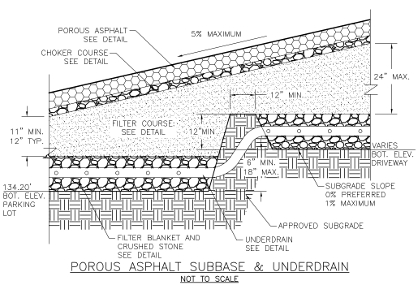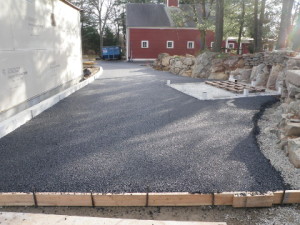by Kristopher Houle, P.E.
A longer version of this article, including several references, originally appeared on the Ecological Landscape Alliance’s blog.
Many green infrastructure alternatives exist for reducing stormwater runoff. Porous asphalt is one that has clear benefits.
In New England, porous asphalt has been used successfully in sidewalks, parking lots, subdivision roads, and highways. Research has demonstrated its function for stormwater attenuation, recharging local waterways, runoff treatment, and chloride source control. As an engineer and practitioner, I commonly see projects that would benefit from its use, but porous asphalt has been excluded from the final design for reasons relating to the degree of slope. Although it may not be the solution for every site, we have strategies for dealing with slope constraints.
Case Study: Animal Rescue League
In 2010, the Horsley Witten Group, in partnership with ARQ Architects, was retained by the Animal Rescue League to redevelop its shelter facility in Dedham, Massachusetts. The league has a strong commitment to sustainable design; it set a LEED Gold certification goal for the project and showed interest from the outset in an innovative stormwater management approach.
The project involved an expansion of the existing structure, additional parking, a new driveway, stormwater infiltration systems, and other amenities to improve the overall experience for visitors and staff members. The facility is located atop a small drumlin hill in northwest Dedham. The slopes surrounding the site are steep, and bedrock outcrops are scattered throughout the property, creating a challenge for siting adequate stormwater management facilities. Because the project would increase impervious area (e.g., asphalt, concrete, and rooftop), stormwater had to be managed to a degree that matched or improved the existing runoff hydrology.
During the initial site evaluation, the team discovered that despite the many outcrops, the site had primarily sand and gravel subsoil, making it suitable for stormwater infiltration in strategic locations. However, the numerous site constraints left only minimal area available for aboveground management facilities. Therefore, the design team considered permeable pavement for the proposed paved surfaces. After a thorough review of options, the design team selected porous asphalt for its cost, LEED credits, local availability, and documented effectiveness in runoff treatment and attenuation.
Slope Challenges
The proposed porous asphalt surfaces included the primary visitor parking lot and a driveway for secondary building access and solid waste pickup. Parking lot constraints included underground electric and water lines that would remain in place during and after construction. The driveway was surrounded by outcrops and the new building’s foundation. The proposed pavement slopes were as high as 5%.
The literature suggests that permeable pavement should not be used on slopes exceeding 5%; however, little research has been done on how a system might function with slopes greater than 5%.
As the slope of a permeable surface increases, the potential for runoff from that surface also increases. At 10%, the potential is high, particularly after several years of use and gradual clogging of the permeable surface. At 5%, the correlation may not be as direct, and may depend instead on the maintenance regime and quality of the material installation. Subsurface erosion, settling, and clogging of the system subbase may occur if water does not collect and infiltrate evenly over the subsoils. At 10%, it may be cost prohibitive to construct a flat subbase to prevent subsurface erosion, but at 5%, design alternatives may be able to limit excavation and earthwork fees. One such strategy was employed for the driveway design at the Animal Rescue League site.
A Tiered Solution

Depiction of the tiered drainage underlying the Animal Rescue League’s porous pavement./Kristopher Houle
Because the site’s slopes were steep and the likelihood of encountering bedrock was high, Horsley Witten designed the driveway subbase as a tiered system, providing a uniform 2% slope of the pavement surface. The driveway profile includes a series of underground basins with flat bottoms to promote infiltration. The basins are separated by a low-permeability soil barrier to prevent lateral water movement.
Although a 5% maximum surface slope is generally preferred, this methodology can make slopes of even 7% or 8% acceptable for limited applications or in highly permeable soils. Although the Animal Rescue League project may be of small scale, the methodology can be transferred to larger sites, such as commercial parking lots, subdivision roads, and residential driveways.
Kristopher Houle is a project engineer at the Horsley Witten Group supporting civil engineering, ecological restoration, and stormwater management projects. He can be reached at khoule@horsleywitten.com



Sorry, the comment form is closed at this time.